
Research
Security News
Lazarus Strikes npm Again with New Wave of Malicious Packages
The Socket Research Team has discovered six new malicious npm packages linked to North Korea’s Lazarus Group, designed to steal credentials and deploy backdoors.

Because your Python code is not JUST a script !
HsPyLib is not just a Python library; it's a gateway to elevating your programming experience to new heights. Built on established principles like SOLID, DRY (Don't Repeat Yourself), KISS (Keep It Simple, Stupid), and YAGNI (You Ain’t Gonna Need It), HsPyLib offers a wealth of frameworks and features. It empowers you to craft sophisticated Python3 applications, adhering to the philosophy that code should not merely be a simple script - it should be a part of the 'PYCSNBASS' (Python Code Should Not Be A Simple Script) mindset.
This project is a part of the HomeSetup project.
Create beautiful menu-select inputs
class SelectableItem:
def __init__(self, name: str, value: str):
self.name = name
self.value = value
def __str__(self):
return f"Name: {self.name} Value: {self.value}"
def __repr__(self):
return str(self)
if __name__ == "__main__":
quantity = 22
digits = len(str(quantity))
it = [SelectableItem(f"Item-{n:>0{digits}}", f"Value-{n:>0{digits}}") for n in range(1, quantity)]
sel = mselect(it)
print(str(sel))
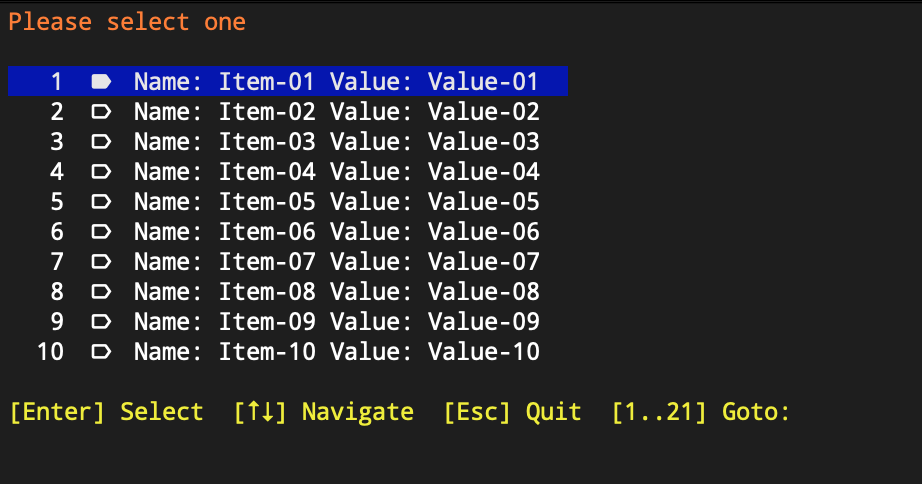
And create beautiful menu-choose inputs
class ChooseableItem:
def __init__(self, name: str, value: str):
self.name = name
self.value = value
def __str__(self):
return f"Name: {self.name} Value: {self.value}"
def __repr__(self):
return str(self)
if __name__ == "__main__":
quantity = 22
digits = len(str(quantity))
it = [ChooseableItem(f"Item-{n:>0{digits}}", f"Value-{n:>0{digits}}") for n in range(1, quantity)]
sel = mchoose(it, [n % 2 == 0 for n in range(1, quantity)])
print(str(sel))
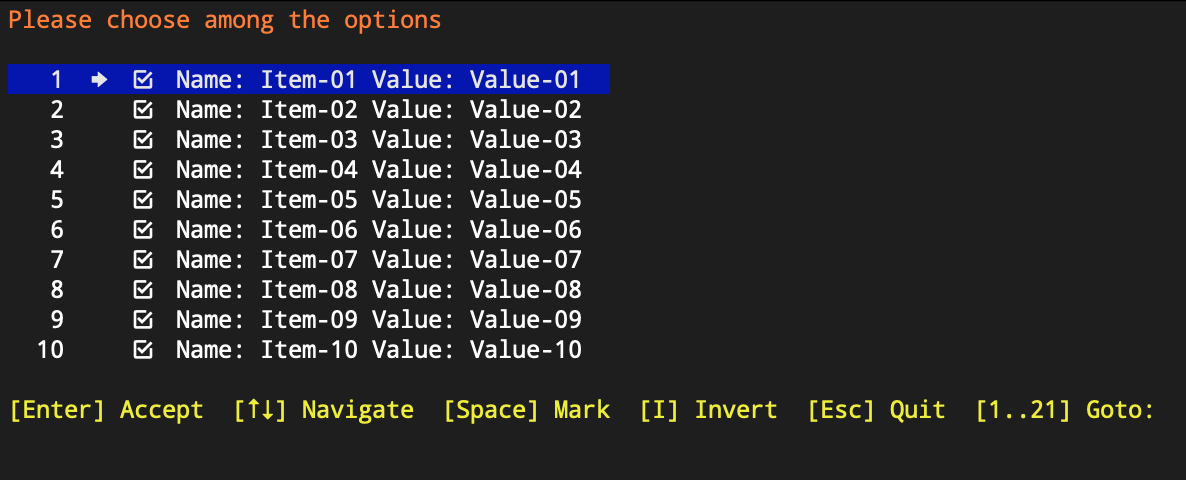
And also, create beautiful form inputs
from clitt.core.tui.minput.input_validator import InputValidator
from clitt.core.tui.minput.minput import MenuInput, minput
if __name__ == "__main__":
# fmt: off
form_fields = MenuInput.builder() \
.field() \
.label('letters') \
.validator(InputValidator.letters()) \
.build() \
.field() \
.label('word') \
.validator(InputValidator.words()) \
.build() \
.field() \
.label('number') \
.validator(InputValidator.numbers()) \
.min_max_length(1, 4) \
.build() \
.field() \
.label('masked') \
.itype('masked') \
.value('|##::##::## @@') \
.build() \
.field() \
.label('selectable') \
.itype('select') \
.value('one|two|three') \
.build() \
.field() \
.label('checkbox') \
.itype('checkbox') \
.build() \
.field() \
.label('password') \
.itype('password') \
.validator(InputValidator.anything()) \
.min_max_length(4, 8) \
.build() \
.field() \
.label('read-only') \
.access_type('read-only') \
.value('READ-ONLY') \
.build() \
.build()
# fmt: on
result = minput(form_fields)
print(result.__dict__ if result else "None")
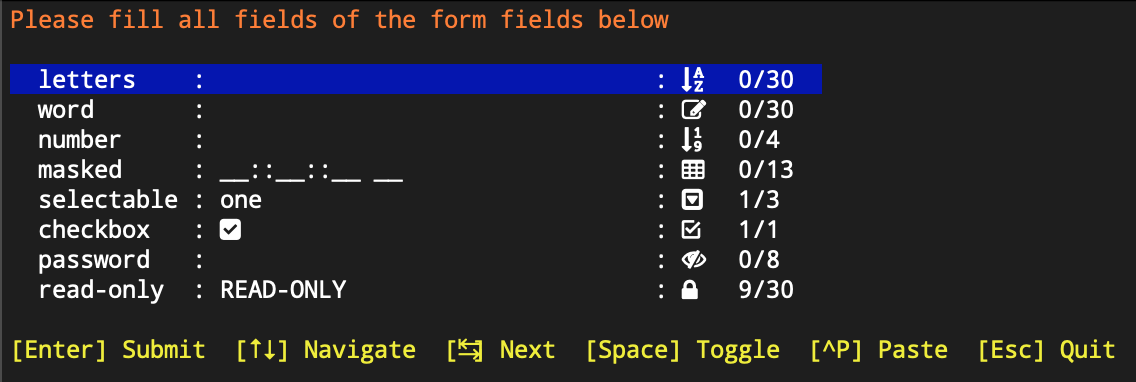
Or even, create nice dashboards:
if __name__ == "__main__":
# fmt: off
dashboard_items = MenuDashBoard.builder() \
.item() \
.icon(DashboardIcons.POWER) \
.tooltip('Do something') \
.on_trigger(lambda: print('Something')) \
.build() \
.item() \
.icon(DashboardIcons.MOVIE) \
.tooltip('Another something') \
.on_trigger(lambda: print('Another')) \
.build() \
.item() \
.icon(DashboardIcons.NOTIFICATION) \
.tooltip('Notify something') \
.on_trigger(lambda: print('Notification')) \
.build() \
.item() \
.icon(DashboardIcons.LIST) \
.tooltip('List everything') \
.on_trigger(lambda: print('List')) \
.build() \
.item() \
.icon(DashboardIcons.DATABASE) \
.tooltip('Database console') \
.on_trigger(lambda: print('Database')) \
.build() \
.item() \
.icon(DashboardIcons.EXIT) \
.tooltip('Exit application') \
.on_trigger(lambda: print('Exit')) \
.build() \
.build()
# fmt: on
result = mdashboard(dashboard_items)
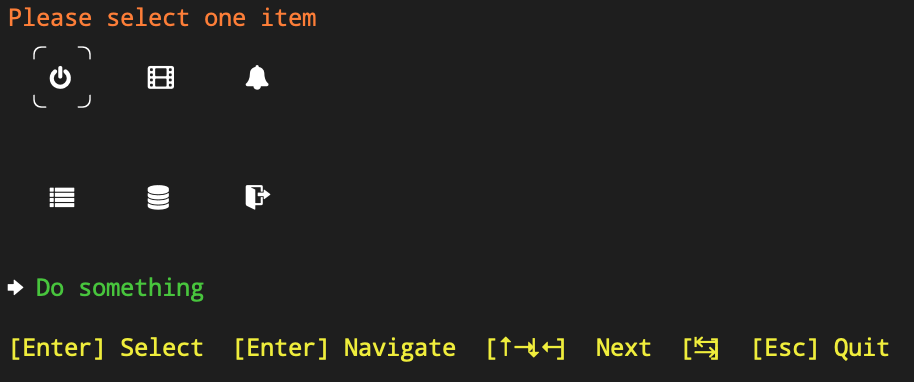
And even more, create beautiful menus !
if __name__ == "__main__":
# fmt: off
main_menu = TUIMenuFactory \
.create_main_menu('TUI Main Menu', tooltip='Test Terminal UI Menus') \
.with_item('Sub-Menu-1') \
.with_action("DO IT 1", "Let's do it") \
.on_trigger(lambda x: print("ACTION 1", x)) \
.with_view("Just a View 1", "Show the view 1") \
.on_render("MY BEAUTIFUL VIEW 1") \
.with_action("Back", "Back to the previous menu") \
.on_trigger(TUIMenuUi.back) \
.then() \
.with_item('Sub-Menu-2') \
.with_action("DO IT 2", "Let's do it too") \
.on_trigger(lambda x: print("ACTION 2", x)) \
.with_view("Just a View 2", "Show the view 2") \
.on_render("MY BEAUTIFUL VIEW 2") \
.with_action("Back", "Back to the previous menu") \
.on_trigger(TUIMenuUi.back) \
.then() \
.then() \
.build()
# fmt: on
TUIMenuUi(main_menu, "TUI Main Menu").execute()
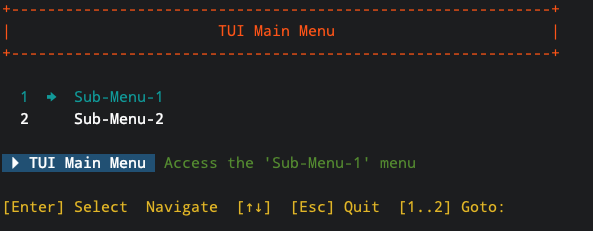
You may want to install HsPyLib on other OS's and it will probably work, but there are no guarantees that it WILL ACTUALLY WORK.
The following software are required:
There are some python dependencies, but they will be automatically downloaded when the build runs.
To install HsPyLib from PyPi issue the command:
# python3 -m pip install hspylib
To upgrade HsPyLib use the command:
# python3 -m pip install hspylib --upgrade
Additional modules that can also be installed:
# python3 -m pip install hspylib-clitt to install HsPyLib CLI terminal tools.# python3 -m pip install hspylib-firebase to install HsPyLib Firebase application.# python3 -m pip install hspylib-vault to install HsPyLib Vault application.# python3 -m pip install hspylib-kafman to install Kafka manager.# python3 -m pip install hspylib-datasource to install datasource helpers.# python3 -m pip install hspylib-hqt to install HsPyLib PyQt framework.To clone HsPyLib into your local machine type the command:
# git clone https://github.com/yorevs/hspylib.git
The API documentation can be found here
Your support and contributions are greatly appreciated in helping us improve and enhance HomeSetup. Together, we can make it even better!
You can support HomeSetup by donating or contributing code. Feel free to contact me for further details. When making code contributions, please make sure to review our guidelines and adhere to our code of conduct.
You can also sponsor it by using our GitHub Sponsors page.
This project is already supported by:

Thank you <3 !!
FAQs
HsPyLib - Apache Kafka Manager
We found that hspylib-kafman demonstrated a healthy version release cadence and project activity because the last version was released less than a year ago. It has 1 open source maintainer collaborating on the project.
Did you know?

Socket for GitHub automatically highlights issues in each pull request and monitors the health of all your open source dependencies. Discover the contents of your packages and block harmful activity before you install or update your dependencies.

Research
Security News
The Socket Research Team has discovered six new malicious npm packages linked to North Korea’s Lazarus Group, designed to steal credentials and deploy backdoors.

Security News
Socket CEO Feross Aboukhadijeh discusses the open web, open source security, and how Socket tackles software supply chain attacks on The Pair Program podcast.

Security News
Opengrep continues building momentum with the alpha release of its Playground tool, demonstrating the project's rapid evolution just two months after its initial launch.